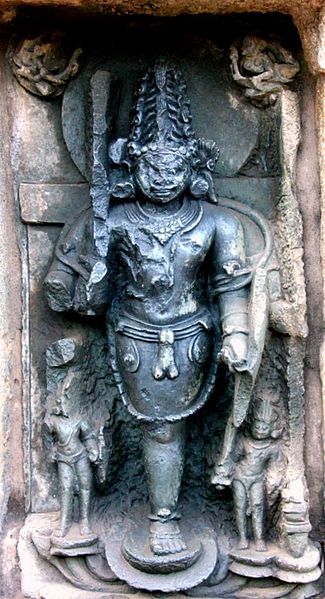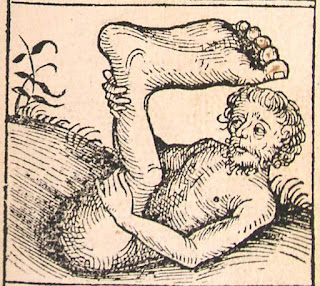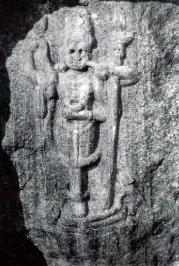The Origins of One-Foot September 30, 2012
Author: Beach Combing | in : Ancient, Medieval, Modern , trackback***Dedicated to Leif***
Humanity has the habit of peopling the edges of its maps with unusual creatures: the ‘there-be-dragons’ phenomenon. We have previously on this blog looked at dog-heads, for example, both in relation to India and Ethiopia. Dog-heads can be explained, as perhaps can unicorns and even dragons and cyclops. But how do you explain the Sciapodi (‘shadow feet’) or the Monocoli (‘single legs’). These appeared in a now lost passage of the Greek geographer Ctesias who took a great interest in Persia (where he had lived) and India (which he seems not to have visited). By great good fortune Pliny paraphrased Ctesias’ lost words in his Natural History:
idem hominum genus, qui Monocoli vocarentur, singulis cruribus, mirae pernicitatis ad saltum; eosdem Sciapodas vocari, quod in maiore aestu humi iacentes resupini umbra se pedum protegant. non longe eos a Trogodytis abesse, rursusque ab his occidentem versus quosdam sine cervice oculos in umeris habentes. sunt et satyri subsolanis Indorum montibus (Catarcludorum dicitur regio), pernicissimum animal, iam quadripedes, iam recte currentes humana effigie; propter velocitatem nisi senes aut aegri non capiuntur.
The same author [Ctesias] writes that the race of men who are called the Monocoli have one leg but show amazing agility by jumping. These same men are also called the Sciapodes because when it is hot, they lay on the ground on their back and shade themselves with their feet. They inhabit a region not far from the Troglodytes. Turning again to the west from these people are those who lack necks and have eyes on their shoulders. There are also satyrs in the mountains of the eastern part of India in the region of the so-called Catarcludi. Satyrs are extremely swift animals running sometimes on all fours and sometimes upright in imitation of a human. Because of their speed, they are never captured unless old or sick.
Let’s leave the poor, tired satyrs for another day and concentrate on these one footers. There has long been the suspicion that Pliny may have got confused here and mixed too different races, the monocoli who had one leg and the sciapodae who had two legs with two enormous feet and who sat in their shade of their ten toes. Certainly, another Greek writer Scylax (in a reported fragment) describes the sciapodae as having two feet. This means that Pliny is responsible for the medieval and early modern illustrations that have a single-legged man holding his foot over his head. He is also responsible for some memorable passages in Voyage of the Dawn Treader.
Again though let’s brush the sciapodes aside and concentrate on the monocoli, the true one-footed creatures of antiquity. They bounce down through the centuries appearing in Aulus Gellius, Augustus (who describes a mosaic showing fantastic creatures in Carthage), then on into medieval poetry and prose. Perhaps their most curious reappearance is in Scandinavian literature where they appear in Eric the Red’s Saga just before the mythical Ireland the Great is described:
One morning Karlsefni’s people beheld as it were a glittering speak above the open space in front of them, and they shouted at it. It stirred itself, and it was a being of the race of men that have only one foot, and he came down quickly to where they lay. Thorvald, son of Eirik the Red, sat at the tiller, and the One-footer shot him with an arrow in the lower abdomen. He drew out the arrow. Then said Thorvald, ‘Good land have we reached, and fat is it about the paunch.’ Then the One-footer leapt away again northwards. They chased after him, and saw him occasionally, but it seemed as if he would escape them. He disappeared at a certain creek. Then they turned back, and one man spake this ditty: ‘Our men chased (all true it is) a One-footer down to the shore; but the wonderful man strove hard in the race…. Hearken, Karlsefni.’ Then they journeyed away back again northwards, and saw, as they thought, the land of the One-footers. They wished, however, no longer to risk their company. (Sephton)
Nor is this the last New World reference – though it is certainly the first. The one footer turns up in, of all places, South American legend in the figure of the terrifying patasola or the one-foot of Columbian lore, a kind of jungle mermaid who lures loggers into the wood for a courtship from which they will never return. There has been much interesting work done in the last generation on the fusion of New World and Old World legends in Latin America and this is presumably a European contribution. Other late instances include a claim on the part of that lying dog Sir John Mandeville ‘There are [in Ethiopia] some that have only foot, and yet they run so fast on that one foot that it is a marvel to see them. That foot is so big that it will cover and shade all the body from the sun.’ Sound familiar?
So much for the success of the legend but now for the impossible question. How do we explain one foot’s origins? The most common suggestion is that the one foot comes from bemused western encounters with yogis balancing on one foot. Is there any aspect of yoga that could explain the rapid jumping? Beach knows that the lotus posture becomes a launching pad for a jump, but that doesn’t involve one leg or does it? drbeachcombing AT yahoo DOT com Another possibility would be that the one leg is a half creature, a man or woman cut in half: such as popularised by Calvino in his The Cloven Viscount. These creatures are common in Arabic lore and may be the origins of Plato’s divided man in the Symposium.
However, a more likely explanation are the one-legged demons and gods of Indian lore. The Vedas, which pre-date Ctesias by perhaps a thousand years, include references to Aja Ekapada ‘the one-footed goat’, a demon: note the (significant?) association in Pliny with satyrs above. The Harivamsha, which post dates Ctesias, includes references to the ekapada demon, the one-footers, which in Indo-European terms is not so distant from the Columbian patasola on the other side of the world. Ekapada also refers, in more developed Hinduism, to a one-footed aspect of the god Shiva of which there are some striking images that survive from the subcontinent.
In other words this was not the case of a western misunderstanding. It was rather the result of listening a bit too carefully to Indian stories – with the help of soma? – or even coming into contact with Hindu iconography of the ekapada. It also gives us the pleasing finale that the one-leg who shot at the Erik on the Canadian coast and the lascivious woman who drags loggers into the green in Columbia come ultimately from the pantheon of pre-classical India.





